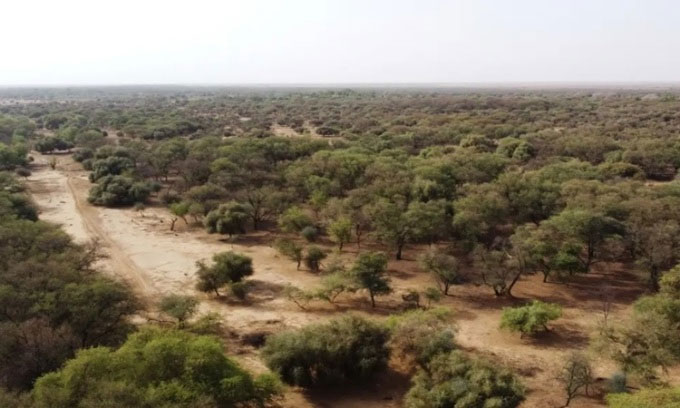The 'Great Green Wall' project lasts 17 years, worth 36 billion USD to help prevent desertification
After 17 years, the "Great Green Wall" project has restored more than 7.7 million hectares of land across Africa.
Over the past few decades, deforestation, agricultural expansion and drought have all contributed to desertification in many parts of the African continent. The fertile soil becomes dry and less productive. More than a dozen African countries are fighting desertification with an ambitious project to grow trees and crops on 100 million hectares of land , an area 2.3 times larger than California. The goal of the 17-year-old Great Green Wall (GGW) project (also known as the Great Green Wall) with an estimated cost of $36 - $49 billion also includes creating 10 million jobs and reducing 250 million jobs. million tons of carbon by 2030, according to Business Insider .

Trees grown in Walalde, Senegal. (Photo: Reuters).
Countries from Senegal to Djibouti are trying to re-green the semi-arid Sahel, a stretch of land stretching from the Atlantic Ocean to the Red Sea. West Africa's forests once covered more than 129,500 km 2 . Since 1975, deforestation, mainly to expand agriculture, has reduced the forest area to about 82,880 square kilometers , according to the US Geological Survey. In addition to making land less fertile, desertification makes soil more vulnerable to wind erosion and reduces its ability to retain moisture. It also leads to loss of biodiversity in flora and fauna. All of these factors make it more difficult for humans to survive.
The African Union officially began the project in 2007. The GGW initially included 11 countries: Burkina Faso, Chad, Djibouti, Eritrea, Ethiopia, Mali, Mauritania, Niger, Nigeria, Senegal, and Sudan. Within a few years of its inception, many other countries joined in. At first, the project aimed to fill a 16 x 7,000 km area of the Sahel with trees. Trees can help slow soil erosion, absorb carbon dioxide, and promote biodiversity through providing food and shelter for animals.
However, critics point out many shortcomings, and the project faces a number of hurdles. The big problem with tree planting plans is the trees themselves. Some young trees grow poorly or die. They are grown in remote areas, making care difficult. Warming temperatures and low rainfall also contribute to the problem. Some communities believe that the government did not fully involve local indigenous people in the project. Governments in many other countries intentionally relocate many people from homes located in forests and conservation areas.
GGW's success has also been difficult to track in some areas. Independent experts have had trouble verifying some government data. In 2020, the project was only 4% complete. In 2021, world leaders pledged $19 billion to support measurement and promote project success.
At that time, GGW's focus began to shift to incorporating traditional planting and irrigation methods. Before GGW began, locals in parts of Niger and Burkina Faso began using a technique called farmer-managed natural regeneration. Instead of planting new trees, farmers in south-central Niger encourage taking care of existing shrubs and trees. That activity helped regreen 4.9 million hectares and plant 2 million trees. In Burkina Faso, farmers relied on traditional experience to adjust after droughts in the 1970s and 1980s. They dug deep holes called zai and installed stone barriers to help collect and retain moisture.
Since the inception of GGW, many countries have achieved success with small projects initiated by farmers. In Senegal, farmers started planting zai gardens during the Covid-19 quarantine period. Named Tolou Keur in the Wolof language, the semicircular holes contain and direct water to plants. Although not every Tolou Keur survives, many are thriving. Farmers grow everything from sorghum to hibiscus. Semicircle pits are built very quickly, do not take up much space and only require about 10 people to maintain.
Drones and satellites have recently begun providing detailed information about reclaimed land, using AI to identify individual tree species. Many tech startups and organizations like the Food and Agriculture Organization of the United Nations (FAO) are collaborating to help communities in the Sahel map and monitor baobab tree populations, helping to reduce soil erosion. Ethiopia, Niger, and Senegal are all re-greening their lands. In addition to the zai garden, Senegal has planted 20,234 hectares of trees. In 2023, the United Nations Development Program reported the GGW project was 18% complete, restoring more than 7.7 million hectares of land and creating 350,000 jobs.
- Green wall helps Africa cope with desertification
- Nearly $ 500 billion
- Unprecedented in Africa: The giant green 'wall' is over 8,000km long stretching across 20 countries
- The Great Wall could not stop the Mongols
- America discovered the largest oil field worth 900 billion USD
- Google spends $ 1 billion on green energy
- Is planting in the desert good or bad?
- Asteroid worth nearly 5 billion USD is rushing to Earth
- Indonesia decided to build a huge sea wall to save the capital
- USA: President Bush announced a plan of $ 7.1 billion against bird flu
- It sounds crazy, but this hundred billion dollar project could save the Earth
- The length of the Great Wall increased twice
 Is the magnetic North Pole shift dangerous to humanity?
Is the magnetic North Pole shift dangerous to humanity? Washington legalizes the recycling of human bodies into fertilizer
Washington legalizes the recycling of human bodies into fertilizer Lightning stone - the mysterious guest
Lightning stone - the mysterious guest Stunned by the mysterious sunset, strange appearance
Stunned by the mysterious sunset, strange appearance